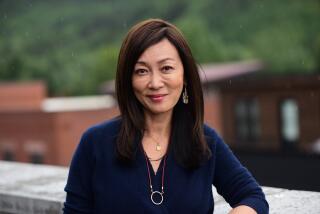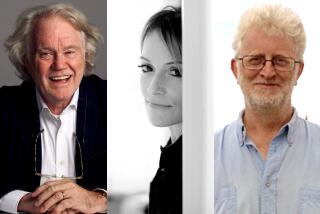Q&A: Scott O’Connor on ‘Half World,’ MKUltra and CIA mind control
From 1953 to 1973, the Central Intelligence Agency spearheaded Project MKUltra, a covert and illegal operation of extreme mind control. For decades, CIA analysts under MKUltra clandestinely questioned American and Canadian citizens through involuntary drug and brainwashing experiments.
Scott O’Connor was inspired by these events in his second novel, “Half World” (Simon & Schuster, $26). It’s the story of Henry March, a CIA analyst who conducts secret mind-control experiments in San Francisco. March tries to separate his life as a CIA analyst (assigning himself the alias Henry Gladwell when he is on the job) from his life across the bay as a husband and father of two.
But as time passes and he falls deeper into the monstrous mind-control experiments, the line blurs and March eventually reaches a breaking point.
O’Connor, who is based in Los Angeles, spoke to us by phone about the CIA’s early days, MKUltra and what it takes for a man to go from living a normal life to torturing a fellow citizen.
O’Connor will be reading at Skylight Books on Tuesday at 7:30 p.m.
You tell the story of a clandestine operation through the eyes of a CIA analyst — someone who you wouldn’t usually think of as a victim. Why tell the story through his eyes?
One of the questions I had going into the novel was: What did it take to move someone from what we would consider a normal life to more extreme behavior. The time I was beginning to do research for the novel was about the same time the Abu Ghraib photographs began to surface during the Iraq War. And I can remember looking at them with the same horror that I think just about everyone else felt.
But also, wondering about the perpetrators of the abuse and finding it hard to imagine that a couple years before the incident, that these people would ever have believed that they would have found themselves in that position. In a room, in a foreign country, alone with a man with a hood on his head, torturing him.
I wanted to know how you got from point A to point B in a situation like that. So Henry March is that type of character. He’s someone who starts out with a seemingly very normal life, for a CIA analyst, and within a hundred pages, is torturing his fellow citizens.
Your main character is essentially two characters in one: Henry March and Henry Gladwell. What was it like writing a main character who has a double life, especially when each of his worlds affects the other?
It developed for me as a writer in much of the same way it developed for Henry March as a character. In the beginning, the other persona that he takes on, is really something of a formality — it’s just so that he can operate in both worlds.
But as the story goes on, that line really begins to blur. He begins to see himself almost as two different people. He compartmentalizes that Henry Gladwell, his CIA persona, is capable of doing these monstrous things. And Henry March is the guy who goes home to his wife and his two children across the bay in Oakland and tries to live a normal life. Obviously those two things can’t be reconciled for very long. So his personality splits into those two very distinct people. ...
Why was this particular time period within the CIA of such interest to you?
The first part of the book takes place in the mid 1950s and that was really the early days of the CIA, which came into being in the late ‘40s. The United States had never really had an intelligence service before. They had the OSS in World War II, but they had never had a peacetime intelligence service.
The rules had not been written yet. There was a lot of throwing things at the wall to see what would stick. They had recruited a lot of very smart people, most of them were men at the time, who had very high ideals and wanted to save the world. They thought they were in a death match with the Soviet Union and the smarter country was going to win. It was who can outthink the other. And they tried all sorts of crazy things, including MKUltra, which was this mind-control project.
I was really interested in that period where it seemed like there weren’t any rules yet.
Most records pertaining to MKUltra were deliberately destroyed in 1973. What type of research did you do in order to understand this world and what both the CIA analysts and their subjects were experiencing?
There’s still some documenting of it that has been uncovered in the last 20 to 30 years. There are a couple of very good books that had written about that information. There were also congressional hearings on this which were really fascinating, particularly for the way the CIA agents’ identities were being questioned by the congressmen. They went complete circles around the congressmen for days at a time without letting out any pertinent information.
There are huge gaps in the story. There are more gaps than there are facts at this point. So for a fiction writer, to me that’s a tremendous opportunity. Trying to figure out what may have happened. And trying to tell a story about what may have happened.
I don’t know if I would have been as interested in the MKUltra program if a lot more about it were known. One of the fascinating things to me about researching was that it was like a mystery story.
Throughout the novel, you jump back and forth in time and location. Why did you choose to tell the story in that format?
I think mostly that came from my research. Like I said, there were these huge gaps in so researching was a fairly frustrating experience. You would be reading about something and then that story, before it was over, would end. And it would be on to another piece of information that seemingly didn’t have much to do with the first.
But I found that when I stuck with it, eventually things would double back. I would start to see patterns and I would start to see figures reemerge who I had read about however many pages earlier. And there was something really exciting about that. I felt like not only was I uncovering a bit of a mystery, but the process was a bit of a mystery. I didn’t know who was going to show up next. I didn’t know who was going to be a main character in the research next.
And I wanted to translate some of that excitement into the book — you never really know which character the baton is going to be passed to next in the book. Or who’s going to come back or not come back.
Throughout the novel, you take on the point of views of several different characters. How did you find a rhythm in balancing these different voices?
It depended on the characters. Some of their voices came very quickly. Jimmy Dorn’s voice to me came very quickly — I understood him immediately. Henry March’s was a little slower in coming. His daughter, Hannah March, who plays a pretty big role later in the book as an adult, her voice came fairly quickly. So it was half and half. In some characters, you understand their rhythm early on, and in some, it takes a lot more work to get to.
I would follow the ones who had the strongest voice. There were other voices that I ended up cutting in different revisions of the book, because the voice never quite worked and it seemed like they weren’t quite adding to the story. It seemed like the characters with the strongest voices had the most to say about the overall story. I tended to follow whoever’s voice was strongest at the moment.
And in terms of who came in when, it’s really by feel. It’s like listening to a piece of music. You try to listen to which sound should be coming in at which time. What feels right as you move along.
ALSO:
‘Train’ lovingly tracks rail history
Photo gallery: A look at the houses of literary lions
B.J. Novak talks about getting into the family business with ‘One More Thing’
More to Read
Sign up for our Book Club newsletter
Get the latest news, events and more from the Los Angeles Times Book Club, and help us get L.A. reading and talking.
You may occasionally receive promotional content from the Los Angeles Times.







